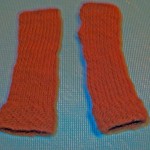One of my father’s joke bits of wisdom is “everything in moderation, including moderation.” When I first studied philosophy academically, I was very much taken with Aristotle’s concept of the “golden mean,” which (this is a gross oversimplification) advocates living in moderation as a way of right living. Pantanjali in the niyamas in his Yoga Sutras invites the yogin to balance effort (tapas) and surrender (ishvara pranadhana) in our practice. The Bhagavad Gita suggests that extreme austerities are just as indulgent as wildly excessive consumption of food, sleep, and comforts.
What does that mean in our modern, middle class lives in a time when we are being confronted head-on with the impact on the earth and our fellow beings of the way we, as a society, have been consuming?
In part, I think it is mindfulness. It is not denial, but balance — choosing ways to consume less, but still not feel deprived. I am fortunate in that much of what we are learning now about both lifestyle and impact (the stuff under the “green living” umbrella) is not new to me. My parents were children of the Depression and my father had a modest income. I went to Quaker youth camp in upstate New York in the 1970s, and I did volunteer work for the first Earth Day when I was in college. We turned the lights off when we weren’t in the room, we turned off the faucets when we were brushing our teeth, or lathering our hair in the shower. We creatively changed what we cooked out of Julia Child, Craig Claiborne, Virginia Lee, or Diana Kennedy or the New York Times Food Section with what we learned from Diet for a Small Planet. We wore warmer clothing inside to be able to keep the heat down. It is important for me to try to live mindfully, but I also very much like to be warm and comfortable, love the feel of beautiful fabrics, and one of my greatest pleasures is eating well.
I have a number of reasons I like to keep the heat down in the winter: it feels better on my sinuses because the air is not as dry and I do not like to have to run a humidifier (yet another electrical appliance); it costs a lot of money to keep an old row house at even 65F in the cold months; and I am concerned about my carbon footprint. I can get really cold when I am working at my desk or getting ready for bed. I don’t like being cold, and it seems silly to insist on being miserably uncomfortable just so I can feel better from the perspective of some perceived moral ground. So I try to create a balance.
Hot water bottles and wrist warmers are part of the balance. Two hot water bottles taken to bed (and then I use the water on the plants the next morning) makes going to bed toasty and delightful, but not too hot in the middle of the night. If I am working at home and it is midday, I can warm myself up with a two-minute handstand or a few sun salutes or some abs work or other arm balances. That’s not an option if I am on a conference call or at the office. Nor does it make sense after dinner when it is time to get energetically quiet. The wrist warmers, though, make an amazing difference (I also enjoy wearing them when I start practicing until I warm up as another layer that easily can come on or off. I kind of like the way I look and enjoyed all the complements I got when I was meandering around New York over the holidays. They are a great way to use scrap yarn (especially if you don’t have the time, yarn, or inclination for a larger project — see my post on “Sauca (and the blanket).”
If you want to make your own wrist warmers and you are a fantastic knitter, you can go for four double-pointed needles, multiple colors, and add a thumb section. For those of you who are newer to knitting or who want wrist warmers very quickly, here’s all it takes to make the one’s shown above.
1. Two needles of appropriate gauge and less than a skein of yarn.
2. Measure loosely around your knuckles. That’s the right width for your wrist warmer (notice that the girth of your knuckles and your forearm a couple of inches below the elbow are about the same). Then knit about a two-inch square to make sure you know how many stitches you get per inch horizontally. When you have your gauge correct, unravel your test square to use that yarn in your wrist warmers. I recommend rechecking the gauge about an inch or two into your first wrist warmer to make sure you were right. It is easier to start over at that stage than to try and fix it later or have to give them away to someone larger or smaller (unless you want to).
3. Cast on the correct number of stitches for how many stitches per inch you get with your yarn and needles and the width you measured around your knuckles. It is OK to round to the nearest half inch. First two rows are simple rib — k1, p1. Then do basic plain knitting (k first row, p return row) until the first wrist warmer is about 6-8 inches long and reaches almost the desired length up your lower arm. Then do 6-8 rows of moss stitch (row 1 — k1, p1, row 2, p1, k1) [or you could just do more ribbing]. Cast off. Measure second wrist warmer against the second. Turned inside-out, using the knitting yarn, sew into a tube, leaving a whole for the thumb a the end with just the double row of ribbing. The sewn part at the knuckle end should be about 2/3 to 3/4 inches, then there should be about a 1 1/2 to 2 inch whole (just hold it up on your hand to make sure it fits).
4. They will stretch out as you wear them, but if they are a little too wide or tight, you can wet them and then make them either longer and thinner or shorter and wider by blocking.
4. Bored with the colors you have at home? It’s pretty easy to swap with a fellow knitter.
5. Want to be just a little fancier? Do stripes by alternating colors when you change rows. Want to practice cables. Do one center cable, just remember that it won’t be in the center if you want it to go on the top of your hand; it will start a quarter of the way in.
6. New to knitting? Go into any yarn store, tell them that this is your project, and they’ll tell you a good yarn, what needles you need, and show you how to cast on, knit and pearl. There are farmers at the Dupont Circle Fresh Farm Market on Sunday who have beautiful homespun, hand-dyed yarns. They might not show you how to knit, but they include patterns for hats.
7. Have fun. Be creative. Be part of a fashion wave. Stay warm.



